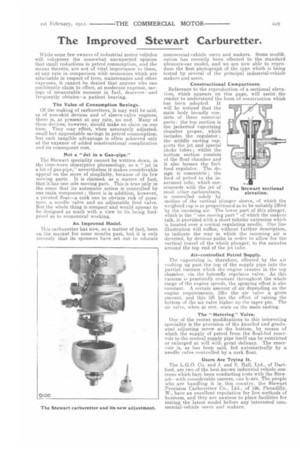The Improved Stewart Carburetter.
Page 5

If you've noticed an error in this article please click here to report it so we can fix it.
While some few owners of industrial motor vehicles will volunteer the somewhat unexpected opinion that small reductions in petrol consumption, and the means thereto, are not of vital importance to them, at any rate in comparison with economies which are attainable in respect of tires, maintenance and other expenses, it cannot be denied that anyone who can confidently claim to effect, at moderate expense, savings of measurable moment in fuel, deserves—and frequently obtains—a patient hearing.
The Value of Consumption Savings.
Of the making of carburetters, it may well be said, as of non-skid devices and of sleeve-valve engines, there is, at present at any rate, no end. Many of these devices, however, should make no claim on our time. They may effect, when accurately adjusted, small but appreciable savings in petrol consumption, but such tangible advantage is often achieved only at the expense of added constructional complication and its consequent cost.
Not a "Jet in a Gas-pipe.'
The Stewart speciality cannot be written down, in the time-worn descriptive phraseology, as a " jet in .a bit. of gas-pipe," nevertheless it makes considerable appeal on the score of simplicity, because of its few moyi rig parts. It is claimed, as a matter of fact, that it has one sole moving part. This is true only in the sense that its automatic action is controlled by one main component ; there is in addition, however, a pivoted float—a cork one to obviate risk of puncture, a needle valve and an adjustable feed valve. But the whole thing is compact and would appear to be designed as much with a view to its being foolproof as to economical working.
An Improved Model.
This carburetter has now, as a matter of fact, been on the market for some months past, but it is only recently that its sponsors have set out to educate commercial-vehicle users and makers. Some modification has recently been effected to the standard pleasure-car model, and we are now able to reproduce the first photograph of the type which is being tested by several of the principal industrial-vehicle makers and users.
Constructional Compactness.
Reference to the reproduction of a sectional elevation, which appears on this page, will assist the reader to understand the form of construction which has been adopted. It will be noticed that the main body broadly consists of three essential parts: the top portion is the jacketted vaporizing chamber proper, which includes the regulator ; the middle casting supports the jet and special choke tubes ; whilst the bottom section consists of the float chamber and it also houses the fuelfeed regulator. The design is concentric ; the feed of petrol to the innermost tube, which corresponds with the jet of most other carburetters, is controlled solely by motion of the vertical plunger sleeve, of which the weighted top is so proportioned as to be suitably lifted by the incoming air. The lower part of this plunger, Which is the " one moving part" of which the makers talk, is provided with a short tubular extension which is located over a conical regulating needle.. Our line illustration will suffice, without further description, to indicate the way in which the incoming air is directed, by devious paths in order to allow for the vertical travel of the whole plunger, to the annulus around the top end of the jet tube.
0 15
The Stewart sectional elevation.
Air-controlled Petrol Supply.
The vaporizing is, therefore, effected by the air rushing up past the top of the supply pipe into the partial vacuum which the engine creates in the top chamber. via the butterfly regulator valve. As this vacuum is practically constant throughout the whole range of the engine speeds, the spraying effect is also constant. A certain amount of air depending on the engine requirements, lifts the air valve a. given amount, and this lift has the effect of raising the bottom of the air valve higher up the taper pin. The air valve, when at rest, seats on the main casting.
The "Metering" Valve.
One of the recent modifications to this interesting speciality is the provision of the knurled and graduated adjusting screw at the bottom, by means of which the supply of petrol from the floaf-fed reservoir to the central supply pipe itself can be restricted or enlarged at will with great delicacy. The reservoir is, as has been said, fed automatically by a needle valve controlled by a cork float.
Users Are Trying It.
The L.G.O. Co. and J. and E. Hall, Ltd., of Dartford, are two of the best-known industrial-vehicle concerns which have been conducting tests with the Stewart---with considerable success, one tipars. The people who are handling it in this country, the Stewart Precision Carburetter Co., Ltd., of 199, Piccadilly, W., have an excellent reputation for live methods of business, and they are anxious to place facilities for testing the latest model before any interested commercial-vehicle users and makers.




















